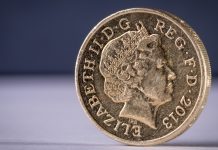In a quiet week as far as economic data is concerned, investors are listening closely to U.S. Federal Reserve speakers.
The dollar strengthened considerably following comments by a Federal Reserve official, causing the euro U.S. dollar exchange rate to dive on Monday. The rate plunged 0.5%, from a high of $1.1212 to a low of $1.1150 for the euro. The euro has struggled to keep its head above $1.1200 since the U.S. Federal Reserve hiked interest rates last week and gave an upbeat outlook on the state of the U.S. economy.
| What do these figures mean? |
|---|
|
When measuring the value of a pair of currencies, one set equals 1 unit and the other shows the current equivalent. As the market moves, the amount will vary from minute to minute. For example, it could be written: 1 EUR = 1.12829 USD Here, €1 is equivalent to approximately $1.13. This specifically measures the euro’s worth against the dollar. If the U.S. dollar amount increases in this pairing, it’s positive for the euro. Or, if you were looking at it the other way around: 1 USD = 0.88789 EUR In this example, $1 is equivalent to approximately €0.89. This measures the U.S. dollar’s worth versus the euro. If the euro number gets larger, it’s good news for the dollar. |
Following the solid victory by Macron’s newly formed party in the French Parliamentary elections, the euro’s reaction was tepid at best. The French stock market was far more jubilant, jumping 1%, whereas the euro struggled against most of its peers.
Looking ahead, today’s economic calendar for the eurozone is also rather bare. German producer prices index, which measures inflation at factory level, could be of interest. Particularly given inflation has been failing to tick up over recent months in the eurozone, despite strong economic data.
U.S. Federal Reserve Speakers boost the buck
The dollar went from strength to strength on Monday after Bill Dudley, head of the New York Federal Reserve, spoke optimistically about the health of the U.S. economy. The influential head confirmed he was pleased with the pace of interest rate rises so far. He also said he believed that inflationary pressures would pick up further as the U.S. labour market continued to tighten.
What does this mean? A tightening labour market is when demand for workers starts to outstrip supply. Employers then raise the salary level of the job in order to attract candidates, which in turn causes wages to move higher.
Dudley is confident that wages in the U.S. will shift higher. This increases inflationary pressure, which then increases interest rate expectations. When interest rate expectations increase, the value of the currency usually moves higher, which is what happened to the dollar yesterday.
Today sees two more Federal Reserve officials speak, one being Vice Chair Fischer and the other being monetary policy committee member Kaplan. More upbeat, optimistic comments regarding the U.S. economy could send the dollar higher as investors could consider that more interest rate rises could be on the horizon.
| Why do raised interest rates boost a currency’s value? |
|---|
| Interest rates are key to understanding exchange rate movements. Those who have large sums of money to invest want the highest return on their investments. Higher interest rate environments tend to offer higher yields. So, if the interest rate or at least the interest rate expectation of a country is relatively higher compared to another, then it attracts more foreign capital investment. Large corporations and investors need local currency to invest. More local currency used then boosts the demand of that currency, pushing the value higher. |
|
This article was initially published on TransferWise.com from the same author. The content at Currency Live is the sole opinion of the authors and in no way reflects the views of TransferWise Inc. |





